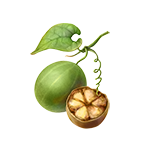 While the sugar content, whether naturally occurring or added during food processing, of many foods can increase blood sugar levels in the body,1 this is not true in every case. For example, monk fruit—a small, round fruit grown in southeast Asia—contains natural sugars such as fructose, but it primarily gains its sweetness from mogroside V, a type of glycoside, which can be extracted for use as a food additive.2 Though glycosides are compounds in which sugar is bound to another functional group by way of a glycosidic bond,3 some research in diabetic rats indicates that monk fruit extract may have an antihyperglycemic effect4 and may limit diabetic complications associated with oxidative stress.4,5 Ban et al6 similarly reported that diabetic rats fed yogurt sweetened with monk fruit showed greater blood glucose regulation and a significant reduction in both insulin resistance and glycosylated hemoglobin concentration compared to those fed yogurt sweetened with sucrose.
While the sugar content, whether naturally occurring or added during food processing, of many foods can increase blood sugar levels in the body,1 this is not true in every case. For example, monk fruit—a small, round fruit grown in southeast Asia—contains natural sugars such as fructose, but it primarily gains its sweetness from mogroside V, a type of glycoside, which can be extracted for use as a food additive.2 Though glycosides are compounds in which sugar is bound to another functional group by way of a glycosidic bond,3 some research in diabetic rats indicates that monk fruit extract may have an antihyperglycemic effect4 and may limit diabetic complications associated with oxidative stress.4,5 Ban et al6 similarly reported that diabetic rats fed yogurt sweetened with monk fruit showed greater blood glucose regulation and a significant reduction in both insulin resistance and glycosylated hemoglobin concentration compared to those fed yogurt sweetened with sucrose.
Stevia gains its sweetness from the actions of an enzyme, uridine diphosphate–dependent glucosyltransferase, which catalyzes the addition of branched glucosides to compounds (primarily stevioside and rebaudioside A) known as steviol glycosides.7 According to Lee et al,8 both steviol glycosides and their glucosylated derivatives demonstrate antihyperglycemic effects by activating glucose-induced insulin secretion. Chang et al9 reported that oral administration of stevioside improves insulin sensitivity in rats. Research has also indicated that stevia may also have preferential effects in people with diabetes; for example, Gregersen et al10 found that stevioside reduced postprandial blood glucose levels in individuals with Type 2 diabetes, and Rashad et al11 observed that stevioside supplementation for 24 weeks improved glycemic control, fasting plasma glucose, two-hour plasma glucose, fasting serum insulin, Homeostasis Model Assessment of Insulin Resistance score, and hemoglobin A1c concentration in people with diabetes.
In addition, at least seven naturally occurring “sweet” proteins are known to exist—thaumatin, monellin, mabinlin, pentadin, brazzein, curculin, and miraculin.12 These proteins may be sourced from various fruits in Africa and Asia,12 and commercialization efforts are ongoing.13
Sources
1. American Diabetes Association. Diagnosis ad classification of diabetes mellitus. Diabetes Care. 2010;33(Suppl 1):S62–S69.
2. Shivani, Thakur BK, Mallikarjun CP, et al. Introduction, adaptation and characterization of monk fruit (Siraitia grosvenorii): a non-caloric new natural sweetener. Sci Rep. 2021;11:6205.
3. Onaolapo AY, Onaolapo OJ. Herbal beverages and brain function in health and disease. In: Grumezescu AM, Holban AM. Functional and Medicinal Beverages. Vol 11. Cambridge, MA: Academic Press; 2019: 313–349.
4. Qi X-Y, Chen W-J, Zhsang L-Q, Xie B-J. Mogrosides extract from Siraitia grosvenori scavenges free radicals in vitro and lowers oxidative stress, serum glucose, and lipid levels in alloxan-induced diabetic mice. Nutr Res. 2008;28(4):278–284.
5. Suzuki YA, Tomoda M, Murata Y, Inui H, Sugiura M, Nakano Y. Antidiabetic effect of long-term supplementation with Siraitia grosvenori on the spontaneously diabetic Goto-Kakizaki rat. Br J Nutr. 2007;97(4):770–775.
6. Ban Q, Cheng J, Sun X, et al. Effects of a synbiotic yogurt using monk fruit extract as sweetener on glucose regulation and gut microbiota in rats with type 2 diabetes mellitus. J Dairy Sci. 2020;103(4):2956–2968.
7. Li Y, Zhu W, Cai J, et al. The role of metabolites of steviol glycosides and their glucosylated derivatives against diabetes-related metabolic disorders. Food Funct. 2021;12(18):8248–8259.
8. Lee SG, Salomon E, Yu O, Jez JM. Molecular basis for branched steviol glucoside biosynthesis. Proc Natl Acad Sci U S A. 2019;116(26):13131–13136.
9. Chang J-C, Wu MC, Liu I-M, Cheng J-T. Increase of insulin sensitivity by stevioside in fructose-rich chow-fed rats. Horm Metab Res. 2005;37(10):610–616.
10. Gregersen S, Jeppesen PB, Holst JJ, Hermansen K. Antihyperglycemic effects of stevioside in type 2 diabetic subjects. Metabolism. 2004;53(1):73–76.
11. Rashad NM, Abdelsamad MAE, Amer AM, Sitohy MZ, Mousa MM. The impact of stevioside supplementation on glycemic control and lipid profile in patients with type 2 diabetes: a controlled clinical trial. Egypt J Intern Med. 2019;31:22–30.
11. Kant R. Sweet proteins—potential replacement for artificial low calorie sweeteners. Nutr J. 2005;4:5.
12. Joseph JA, Skkermans S, Nimmegeers P, Van Impe JFM. Bioproduction of the recombinant sweet protein thaumatin: current state of the art and perspectives. Front Microbiol. 2019;8;10:695.





